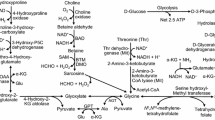Abstract
Purpose
The aim of the present feeding trial with iodine was to assess pigs’ growth performance and carcass characteristics, the iodine accumulation in tissues, and their influences on the thyroid hormones in plasma.
Methods
Eighty pigs (33–115 kg body weight) were allotted to 5 dietary treatments: a control group (150 μg I/kg), two potassium iodide [KI] groups (4,000 and 10,000 μg I/kg), and two potassium iodate [KIO3] groups (4,000 and 10,000 μg I/kg). Iodine concentration was determined in thyroid gland, liver, kidney, muscle, fat, and skin by ICP-MS. Furthermore, thyroxine (T4) and triiodothyronine (T3) in plasma were evaluated.
Results
High dietary iodine tended to have a negative effect on younger animals' growth (average daily gain, ADG). However, during the entire growth period, the growth performance and carcass characteristics were not influenced by iodine dosages or sources. Irrespective of iodine source, higher iodine doses of diets affected higher iodine stores in all tested tissues except for abdominal fat. Thus, iodine supplementation with 10,000 μg I/kg feed significantly increased iodine content in thyroid gland (+122%), liver (+260%), kidney (+522%), muscle (+131%), and skin (+321%) compared to the control group. However, there was no significance of thyroid hormones in plasma.
Conclusions
As a result, pork and fat of pigs showed only low iodine accumulation even in the high-iodine groups. Thus, there should be no risk of an iodine excess in human nutrition and animal health, and the EU-upper level for iodine in pig feed can be maintained.
Similar content being viewed by others
References
Kotwal A, Priya R, Qadeer I (2007) Goiter and other iodine deficiency disorders: a systematic review of epidemiological studies to deconstruct the complex web. Arch Med Res 38:1–14
Pennington JA (1990) A review of iodine toxicity reports. J Am Diet Assoc 90:1571–1581
European Food Safety Authority (2005) Opinion of the scientific panel on additives and products or substances used in animal feed on the request from the commission on the use of iodine in feedingstuffs. EFSA J 168:1–42
Flachowsky G, Schone F, Jahreis G (2006) Iodine enrichment in food of animal origin. Ernährungs-Umschau 53:17–21
European Union (2005) Commission regulation (EC) of 8 September 2005 amending the conditions for authorisation of a number of feed additives belonging to the group of trace elements. The Commission of the European Communities
Schone F, Rajendram R (2009) Iodine in farm animals. In: Preedy V, Burrow G, Watson R (eds) Comprhensive handbook of iodine. Elsevier Academic Press, Oxford
Scientific committee on food (2002) Opinion of the scientific committee on food on the tolerable upper intake level of iodine. European Commission, Bruxelles/Brussels
GfE (2008) Communications of the committee for requirement standards of the society of nutrition physiology—prediction of metabolisable energy of compound feeds for pigs. DLG Verlag, Frankfurt/Main
Naumann C, Bassler R (1997) Die chemische Untersuchung von Futtermitteln. VDLUFA-Verlag, Darmstadt
Benkhedda K, Robichaud A, Turcotte S, Beraldin FJ, Cockell KA (2009) Determination of total iodine in food samples using inductively coupled plasma-mass spectrometry. J AOAC Int 92:1720–1727
Zimmermann MB (2009) Iodine deficiency. Endocr Rev 30:376–408
Kelly FC (1953) Studies on the stability of iodine compounds in iodized salt. Bull World Health Organ 9:217–230
Food and Agriculture of the Organization of the United Nations (2006) Livestock’s long shadow: environmental issues and options. FAO, Rome
Yalcin S, Kahraman Z, Yalcin SS, Dedeoglu HE (2004) Effects of supplementary iodine on the performance and egg traits of laying hens. Br Poult Sci 45:499–503
Rambeck WA, Kaufmann S, Feng J, Hollwich W, Arnold R (1997) Improving the human iodine supply by iodination of swine feed. Tierarztl Prax 25:312–315
He ML, Hollwich W, Rambeck WA (2002) Supplementation of algae to the diet of pigs: a new possibility to improve the iodine content in the meat. J Anim Physiol Anim Nutr (Berl) 86:97–104
Franke K, Schone F, Berk A, Leiterer M, Flachowsky G (2008) Influence of dietary iodine on the iodine content of pork and the distribution of the trace element in the body. Eur J Nutr 47:40–46
Schone F, Zimmermann C, Quanz G, Richter G, Leiterer M (2006) A high dietary iodine increases thyroid iodine stores and iodine concentration in blood serum but has little effect on muscle iodine content in pigs. Meat Sci 72:365–372
Schone F (1999) Iodine deficiency, iodine requirement and iodine excess of farm animals–experiments on growing pigs. Berl Munch Tierarztl Wochenschr 112:64–70
Sandell ED, Kolthoff IM (1937) Microdetermination of iodine by a catalytic method. Mikrochemica Acta 1:9–25
Windisch W, He J, Kirchgessner M (1999) Isotope-dilution technique for determination of endogenous faecal excretion and true absorption of iodine in 125I labelled rats. J Anim Physiol Anim Nutr 82:205–215
Sturup S, Buchert A (1996) Direct determination of copper and iodine in milk and milk powder in alkaline solution by flow injection inductively coupled plasma mass spectrometry. Anal Bioanal Chem 354:323–326
Gelinas Y, Krushevska A, Barnes RM (1998) Determination of total iodine in nutritional and biological samples by ICP-MS following their combustion within an oxygen stream. Anal Chem 70:1021–1025
Knapp G, Maichin B, Fecher P, Hasse S, Schramel P (1998) Iodine determination in biological materials—options for sample preparation and final determination. Fresenius J Anal Chem 362:508–513
Larsen EH, Ludwigsen MB (1997) Determination of iodine in food-related certified reference materials using wet ashing and detection by inductively coupled plasma mass spectrometry. J Anal Atom Spectr 12:435–439
Murray MM, Pochin EE (1951) Thyroid uptake of iodine from ingested iodate in man. J Physiol 114(Suppl):1–14
Murray MM (1953) The effects of administration of sodium iodate to man and animals. Bull World Health Organ 9:211
NRC (2005) Mineral tolerance of animals. National Research Council of the National Academies, Washington, D.C
Author information
Authors and Affiliations
Corresponding author
Rights and permissions
About this article
Cite this article
Li, Q., Mair, C., Schedle, K. et al. Effect of iodine source and dose on growth and iodine content in tissue and plasma thyroid hormones in fattening pigs. Eur J Nutr 51, 685–691 (2012). https://doi.org/10.1007/s00394-011-0247-7
Received:
Accepted:
Published:
Issue Date:
DOI: https://doi.org/10.1007/s00394-011-0247-7




